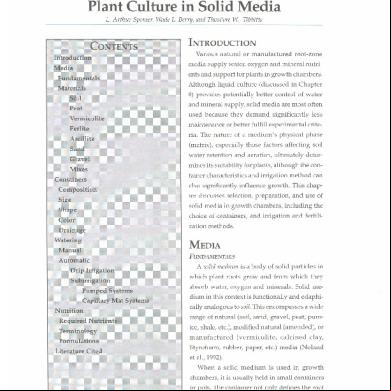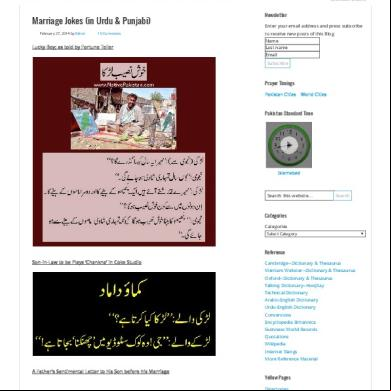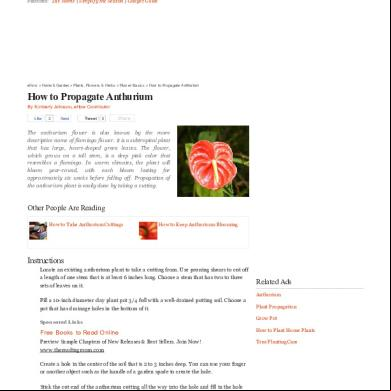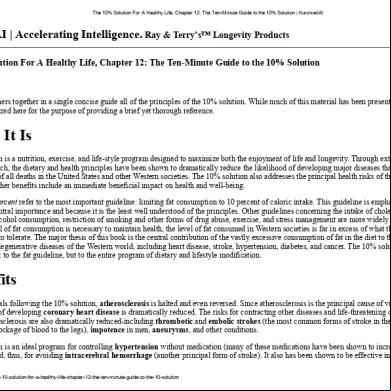Plant Growth Chamber Handbook 6ssq
This document was ed by and they confirmed that they have the permission to share it. If you are author or own the copyright of this book, please report to us by using this report form. Report 3b7i
Overview 3e4r5l
& View Plant Growth Chamber Handbook as PDF for free.
More details w3441
- Words: 960
- Pages: 77
Do we take enough care of plants when there is no market for flowers? Do we take good care of human being when he is ill and not able to work? The answer is “of course yes!” Then why do we neglect the plants which are as living as human beings? Why do we neglect the crop in greenhouse during the period of “poor market”? Again the answer is very simple “to reduce the cost of production”! However; neglecting the crop during this period leads to irreversible damage to the crop and eventually hamper the crop performance when you need flowers to cater high demand of market. And therefore; every grower needs to maintain the crop with minimum inputs wherein the cost is under control and the plants are ready whenever you need them to perform. Following are few tips which will make greenhouse management cost effective & maintain plant healthy and physiologically fit for season:
Basal Dose: One year and more old plants should be given an additional basal dose at the beginning of lean season. Deleafing: This is the process of removal of old and damaged leaves. The lower non – functional leaves; which are either dead or over matured, should be removed and discarded. The crop canopy microclimate should be maintained though. Disbudding: This is the process of removal of the flower buds. This operation should be carried out since these blooms will only deplete the plant nutrients. Fertigation with low EC: The fertigation with low EC will help the crop to sustain and carry out its basic physiological activities and reduce fertilizer costs as well. Moisture Content: “Wapsa”or the optimum moisture condition should never be compromised. During this period; under no circumstances should the plants be exposed to any biotic or abiotic stress. Silicon Spray: Silicon being an anti-stress element will safe guard the plants against any untoward stress. Rooting Hormone: Humic acid drenching; once in 10 days, will also prove useful in the root formation. Preventive sprays: Depending on the existing climatic conditions; regular preventive sprays with Fungicides and Insecticides should be carried out. Regular scouting for pests and diseases should be carried out on priority basis. Soil and water analysis: Once the lean period is over; the EC and pH of the soil should be tested before starting with the full fledged fertigation schedule Note: The regular fertigation schedule has to be commenced two weeks prior to the demand of flowers in the market!
GEARING UP FOR THE MONSOON Just like other season monsoon season also brings along its fair share of challenges; which if not attended timely, can pose threat to the crops inside the greenhouse. And they are such as: Limited interception of Photo synthetically Active Radiation into the greenhouse due to overcast skies, Humidity stagnation, soggy soil condition for prolonged period etc. These unfavorable greenhouse conditions make it highly conducive for the survival and multiplication of pests and diseases. Following are the guidelines which would help in reducing the adverse effects. 1) Light: During monsoon light becomes the limiting factor. To clean plastic top before the onset of monsoon is very important! Once the monsoon sets in; keep the shade nets open throughout the day to use the available light which penetrates the plant canopy. This will optimize the bud initiation and enhance the evaporation of excessive soil moisture. 2) Air circulation: Irrespective of monsoon (and especially during monsoon), the side curtains should be kept as open as possible to facilitate ample air circulation inside the polyhouse to prevent hot pockets. This will also reduce the high levels of humidity & therefore reduce the risk of diseases like Botrytis, Powdery Mildew, Leaf spot etc. 3) Foliage/Vegetation canopy: Kindly maintain 18 to 20 leaves and regularly remove extra leaves to avoid overcrowding. This will facilitate air movement around the plants. While de-leafing; only the lower and old leaves should be gently removed without causing any mechanical injury to the crown portion. Varieties having dense foliage; to facilitate aeration at the crown portion, the foliage near the crown portion should be slightly pressed to expose the crown portion. 4) Disease prevention: Weekly preventive spray schedule has to be carried out to minimize possibility of fungal and bacterial infection. Especially in Carnation; preventive drenching of systemic fungicide (at an interval of 15 days) should be carried out to avoid Fusarium and Rhizoctonia infection. 5) Drenching: Kindly apply half of the regular amount of water a day before and the day after drenching. Do not irrigate the plants on the day of drenching. 6) Pest monitoring: Scouting & preventive action for pests should be followed regularly as advised. 7) Water and nutrient management: Since the quantity of water is reduced; the fertilizer dosage should also be reduced proportionately! Foliar sprays will be better to fulfill the nutrient requirement of the plants; however, foliar sprays should not be applied during evening hours. 8) Water sanitation and nematode prevention: Make sure to have deep trench to avoid flood water getting inside the polyhouse which might cause nematode infection later. To prevent nematode infestation; soil application of Furadan granules @ 15 gm / m2 and drenching of Benlate, Oncol and Metacid alternately at an interval of 15 days should be done. To keep control on nematode population; use of biological organisms like Paecilomyces and Trichoderma are highly recommended. However; no chemical fungicides are istered 2 weeks prior or 20 days after the incorporation of the biological agents. 9) Soil bed management: Addition of organic manures like neem cake, vermicompost, etc. will improve the soil structure and C: N ratio for better quality of plants. Regular shallow raking of top soil is beneficial to improve aeration in soil beds.
Basal Dose: One year and more old plants should be given an additional basal dose at the beginning of lean season. Deleafing: This is the process of removal of old and damaged leaves. The lower non – functional leaves; which are either dead or over matured, should be removed and discarded. The crop canopy microclimate should be maintained though. Disbudding: This is the process of removal of the flower buds. This operation should be carried out since these blooms will only deplete the plant nutrients. Fertigation with low EC: The fertigation with low EC will help the crop to sustain and carry out its basic physiological activities and reduce fertilizer costs as well. Moisture Content: “Wapsa”or the optimum moisture condition should never be compromised. During this period; under no circumstances should the plants be exposed to any biotic or abiotic stress. Silicon Spray: Silicon being an anti-stress element will safe guard the plants against any untoward stress. Rooting Hormone: Humic acid drenching; once in 10 days, will also prove useful in the root formation. Preventive sprays: Depending on the existing climatic conditions; regular preventive sprays with Fungicides and Insecticides should be carried out. Regular scouting for pests and diseases should be carried out on priority basis. Soil and water analysis: Once the lean period is over; the EC and pH of the soil should be tested before starting with the full fledged fertigation schedule Note: The regular fertigation schedule has to be commenced two weeks prior to the demand of flowers in the market!
GEARING UP FOR THE MONSOON Just like other season monsoon season also brings along its fair share of challenges; which if not attended timely, can pose threat to the crops inside the greenhouse. And they are such as: Limited interception of Photo synthetically Active Radiation into the greenhouse due to overcast skies, Humidity stagnation, soggy soil condition for prolonged period etc. These unfavorable greenhouse conditions make it highly conducive for the survival and multiplication of pests and diseases. Following are the guidelines which would help in reducing the adverse effects. 1) Light: During monsoon light becomes the limiting factor. To clean plastic top before the onset of monsoon is very important! Once the monsoon sets in; keep the shade nets open throughout the day to use the available light which penetrates the plant canopy. This will optimize the bud initiation and enhance the evaporation of excessive soil moisture. 2) Air circulation: Irrespective of monsoon (and especially during monsoon), the side curtains should be kept as open as possible to facilitate ample air circulation inside the polyhouse to prevent hot pockets. This will also reduce the high levels of humidity & therefore reduce the risk of diseases like Botrytis, Powdery Mildew, Leaf spot etc. 3) Foliage/Vegetation canopy: Kindly maintain 18 to 20 leaves and regularly remove extra leaves to avoid overcrowding. This will facilitate air movement around the plants. While de-leafing; only the lower and old leaves should be gently removed without causing any mechanical injury to the crown portion. Varieties having dense foliage; to facilitate aeration at the crown portion, the foliage near the crown portion should be slightly pressed to expose the crown portion. 4) Disease prevention: Weekly preventive spray schedule has to be carried out to minimize possibility of fungal and bacterial infection. Especially in Carnation; preventive drenching of systemic fungicide (at an interval of 15 days) should be carried out to avoid Fusarium and Rhizoctonia infection. 5) Drenching: Kindly apply half of the regular amount of water a day before and the day after drenching. Do not irrigate the plants on the day of drenching. 6) Pest monitoring: Scouting & preventive action for pests should be followed regularly as advised. 7) Water and nutrient management: Since the quantity of water is reduced; the fertilizer dosage should also be reduced proportionately! Foliar sprays will be better to fulfill the nutrient requirement of the plants; however, foliar sprays should not be applied during evening hours. 8) Water sanitation and nematode prevention: Make sure to have deep trench to avoid flood water getting inside the polyhouse which might cause nematode infection later. To prevent nematode infestation; soil application of Furadan granules @ 15 gm / m2 and drenching of Benlate, Oncol and Metacid alternately at an interval of 15 days should be done. To keep control on nematode population; use of biological organisms like Paecilomyces and Trichoderma are highly recommended. However; no chemical fungicides are istered 2 weeks prior or 20 days after the incorporation of the biological agents. 9) Soil bed management: Addition of organic manures like neem cake, vermicompost, etc. will improve the soil structure and C: N ratio for better quality of plants. Regular shallow raking of top soil is beneficial to improve aeration in soil beds.










